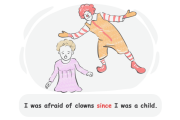Conjunctions of Time
In this lesson, master conjunctions of time to connect events in time using combinations like "when," "while," "before," and "after." Clear explanations and practice exercises to help you learn.

What Are Conjunctions of Time?
Conjunctions of time are words that connect clauses by indicating temporal relationships between them. These conjunctions are used to show a chronological sequence of events or to link two actions that occur at the same time.
Common Conjunctions of Time
Here are the most common conjunctions of time:
Conjunctions of Time: Uses
Subordinating conjunctions of time are used to introduce a subordinate clause that provides time-related information about the main clause. Either clause can be used as the first clause of the sentence, depending on the emphasis that is desired.
I haven't been in China since you left.
When I was sixteen, I broke my leg.
'After' and 'Before'
The subordinating conjunctions 'after ' and 'before' are used to indicate the order in which events occur. 'Before' is used to indicate that the event in the subordinate clause happens later than the event in the main clause, while 'after' is used to indicate that the event in the subordinate clause happens earlier than the event in the main clause. Look at the examples:
She left after the meeting ended.
Here, "the meeting ended" happens earlier than "she left."
She left before the meeting ended.
Here, "the meeting ended" happens later than "she left."
Before she got married, she worked in a bank.
Here, "she got married" happened later than working in a bank.
I graduated after I was nominated for the best actor of the year.
Here, "I was nominated..." happened earlier than graduation.
'When'
The conjunction 'when' is used to indicate the time at which an event occurs, often showing that two actions or events occurred at the same time. It can also be used to indicate that one event occurs immediately after another event. Here are the examples:
I was watching TV when you entered.
at the same time
I got happy when you arrived.
one immediately after another
'While'
When used as a conjunction, 'while' indicates that two events happen at the same time. It is often used when one action is ongoing and another interrupts it. Here are the examples:
While I was talking to you, she stole my keys.
I kissed her on the cheeks while she was smiling.
'Until' and 'By the Time'
'Until' is used to indicate the point in time or an event up to which an action or event occurs. 'By the time' is used to indicate the point in time at which an action or event is expected to be completed. Here are the examples:
I was happy until you came and ruined everything.
Everything will be ready by the time you get home.


'Since'
'Since' is used to refer to a point in time in the past from which an action or event began and continued up to another point in the past or still continues to the present. Here are a few examples:
I was afraid of clowns since I was a child.
I feel better since I have finished my therapy.
'As'
'As' is used to indicate that two events occur simultaneously. It is sometimes used to show a contrast between the two events. Here are the examples:
They stopped talking as I walked through the hallway.
She smiled as she opened the gift.
'As Long as'
As long as is used to indicate the duration of time that an action or event continues. Check out the examples:
We are strong as long as we are together.
They want to stay as long as the party is held.
Punctuation Rules
When conjunctions of time are used to introduce a subordinate clause at the beginning of a sentence, a comma is typically used to separate the subordinate clause from the main clause. However, when the subordinate clause follows the main clause, no comma is needed between the clauses. Here are the examples:
Before he got killed, he had a bad argument with his sister.
I will answer the phone calls as long as I am here.
Review
Conjunctions of time are used to show temporal relations between two events. Here are the most common conjunctions of time in English:
Before/after
When
As long as
While/as
Until/by the time
Since
Quiz:
Which sentence uses "while" correctly?
I'll call you while I arrive at the station.
She read a book while the children played outside.
While the concert ended, we met the band backstage.
He fixed the roof while it stopped raining.
Which sentence does not use "since" as a conjunction of time?
She's lived here since 2020.
Since the train was delayed, we missed the ceremony.
He hasn't eaten sushi since he got food poisoning.
They have been playing tennis since they were in high school.
Sort the words to form a correct sentence.
Match each sentence to the correct function of its conjunction.
Complete each sentence using the correct conjunction of time. (there are two extra options.)
She hasn't visited her hometown
she moved to Paris in 2020.
the professor was explaining the theory, the students took notes.
We can't start the meeting
everyone arrives.
you submit the application, double-check all your details.
Comments
(0)